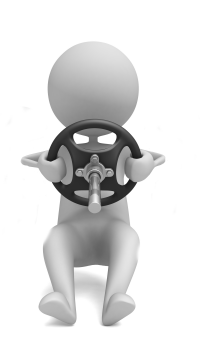Giving Demonstrations - Pitching at an appropriate level
Ways (and ways not) to demonstrate
I have often observed demonstrations where the instructor just drives around and talks while the learner sits passively and listens.
Forget it! (Your learners definitely will!)
If you want to make your demonstrations really effective they will, more often than not, need to be interactive.

‘Expert’ demonstration can occasionally be useful, but the process is often similar to watching an unstructured video. The real value of demonstration occurs when you involve and engage your customers allowing them to ‘drive’ the demonstration process.
How experts demonstrate!
The first rule when giving demonstrations is to ensure that your actions are pitched at a suitable level for the learner.
Learners will gain little from an ‘expert’ standard demonstration if the level of competence required to achieve the task is way beyond their ability. A demonstration pitched at too high a level might discourage the learner from positively attempting a task that they perceive to be too difficult.
Demonstrations are not about how well you can do something; they must be geared to the needs of each individual learner.
With the above points in mind, when giving demonstrations to novice drivers it can often be useful to do everything correctly but in a slightly wooden manner; this can be done by making all your actions deliberate.
Keep your demonstration simple, too much detail might overload your pupils. This means that you might need to give more than one demonstration of the same task, each covering a different aspect of the task – small, easy chunks of learning content (relative to the learner’s current skills/needs) are essential for ‘success based training’.
Finally on method:
Set it up properly. Explain the key points of the topic before and during your demonstration ensuring that your learners understand what they are learning, why they are learning it, why they are learning it via demonstration and what their (active) role is in the process. This is a 'Job sharing' task.
Reasons
You are demonstrating stuff because demonstrations:
- Allow your customers to gain a clear idea of the task that they are about to perform.
- Break up lessons by giving a change of activity.
- Give a physical break for both learner and instructor. Getting out of the car stretches the muscles and the fresh air is revitalising. This is a good enough reason in itself if someone is in a 'stuck state' and struggling for no apparent reason.
- Help learners to see exactly how they made mistakes. (Be careful with this one. Make sure that you keep the car safe when repeating or constructing a mistake.)
- Allow new material to be learned objectively with reduced stress/anxiety levels.
Demonstrations are useful for all of your customers. But they become especially valuable when dealing with those who are reluctant to join in the dialogue of question and answer and when teaching people who do not speak the same language as you; they are absolutely essential when teaching someone who is deaf or hard of hearing or who has a very ‘kinaesthetic’ way of modelling the world.
Here are a few examples of different ways to use demonstration
Detective demonstrations!

As you demonstrate a particular skill or sequence of actions, the learner's job is to ask questions about what you are doing and why you are doing it. Your only verbal input is to answer the questions.
One of the best ways to answer questions in these situations is to pose a further question linked to the demonstration, for example:
Learner: "Why did you change to second gear before the corner?"
Instructor: "That's a really good question, what I'm going to do is drive around the next corner in third gear and then one more corner in second gear and I want you to pay particular attention to the way the car feels and then see if you can answer your own question."
Quiz time demonstrations
Here you drive the car while asking the learner questions about what you are doing.
You can direct the learner's attention to specific actions prior to asking the questions, for example "OK John, I'll be passing a number of parked vehicles on this next section of road and I want you to pay particular attention to my mirrors and signals because I'll be asking some questions about them in a moment. "
You can then ask questions and develop the learner's answers with further questions for example:
- "How many times did I check the mirrors and which mirrors did I use?"
- "What you think the purpose of my door check was?"
- "Why do you think I used the left mirror when we passed the blue van even though I was moving out to the right?"
If your learner is unable to answer a question at any point you can shift the conversation on with something like "So in order to answer that question what will you need to look for when I drive along the same stretch of road again?"
'Instruct me' demonstrations

Here you do a little role reversal - the learner teaches you how to do a specific manoeuvre! I used to do this by getting the learner to follow the key points on a visual aid to guide me step-by-step through the actions (the SmartDriving Visual Teaching System is perfect for this).
Another way to do this is to spend a few minutes developing a sequence of actions with the learner writing them out as bullet points - again do this by asking questions so that it's the learner who is developing the bullet list, not you. Because you are driving it doesn't matter if some of the elements on the list are not correct... This will become apparent during the drive and your learner will be able to work out a solution.
Spot the mistake demonstrations
This game (oops, I mean serious exercise!) is one where you drive the car and make some deliberate mistakes; the learner has to spot the mistakes You then have a discussion about the dangers and alternatives.
This fits nicely with 'instruct me' - after spotting the errors your learner can help you to fix them.
'Let's share the drive' demonstrations
During the ADI MasterClass I discuss this method as an alternative to lesson briefings. Two or three minutes demonstration can effectively become a 'briefing on the move' - however, rather than explaining everything I suggest that you help your customers to work things out for themselves.
As soon as the learner has an understanding of the task he can then start to make decisions from the passenger seat either independently or in response to questions from you. You then play out the decisions, sometimes this can lead to late braking, hesitation or other problems; other times it can lead to a perfect drive. The outcome is unimportant, what is important is the 'data collection' in other words the information that can be used to move the learning forwards.
In as little as five or ten minutes you will find pupils can start making decisions from the passenger seat - this decision making can be practised on the quiet road where the learner will be driving and also on busier roads. When the learner feels ready, he gets back into the driving seat to have a go himself.
Experience has shown that this type of demonstration often completely eliminates the need for any talk-through when the learner gets back into the driving seat. When instructors ask "What input do you want from me?" it's quite common for the learner to say "Can I try it on my own first?"
'Simply watch me' demonstrations
The best learning is based on 'self gathered information'. This is natural learning, it's the way we learn to walk, talk and indeed all the other things we learnt in our early years. When we gather information with your own senses we can make more sense of it than we would by listening to someone else's interpretation of the same information.

For example: I could write pages of information about my tidy desk and working area, but no amount of explanation could give you the 'picture' as well as a photograph.
Looking at a photograph you will start to visually gather information that's important to you - this will be different for different people. (You will also get an idea of what I mean by 'tidy'!)
In turn, a photograph would not give you as much information as you would get if you were to visit me because it does not contain information about the room temperature, the aroma from the essential oils I burn, the view from the window and so on.
One second of 'self gathered' information will often provide more useful data than minutes or even hours of explanation.
For 'Watch me' demonstrations you simply drive with both yourself and the learner sitting quietly. These can be followed up with questions like "What did you notice?" "Is anything you would do differently?" "What was different from the way that your friends drive?" etc. This approach is great for 'spot the solution' if a learner has been struggling with a problem.
This is the final item in this section - next: Keeping Control of The Lesson